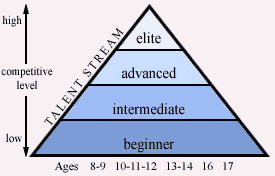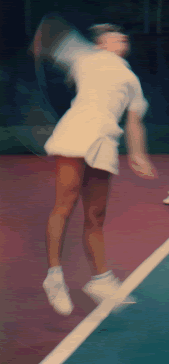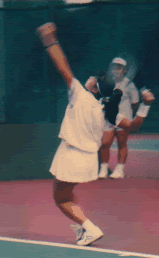Understanding
the Strokes mechanics:
Biomechanics is a key area in a player development because all tennis strokes
have a fundamental mechanical structure. Successful achievement of each stroke
is greatly affected by the technique the player employs. When developing stroke
production an individualised model for performance must then be structured with
due consideration to the key mechanical features of each skill, while considering
the flair and physical characteristics of a player.
Successful tennis performance requires a mix of player talent and player development.
This development requires a player to understand those aspects of sport science
pertinent to tennis if he/she is to ever reach an optimal level of performance.
Up until puberty the emphasis in player
preparation should be on developing stroke production, enhancing
coordinative ability and enjoying the game. Those players post-puberty, who
wish to develop their game fully, must integrate off-court strength/endurance/power
training into their programs. The use of weights, plyometrics, medicine ball
drills and so on, that incorporate a stretch-shorten action should form a part
of this training. Flexibility training methods should be a permanent feature
of player preparation to maintain the appropriate muscular length-tension relationship
that provides for injury prevention and optimal power generation.
Ensuring that players wear proper footwear and change it when needed, as well
as applying orthotics (custom inserts) to the player's shoes are steps that
can be taken to minimize the risk of injury during on-court movement and enhance
performance.
Groundstrokes:
Players need to understand the basic biomechanical principles and how to apply
them to the different components of the strokes. There is no doubt that one
of the most important sources of power for a tennis player comes from the racket.
The new rackets not only allow the players to hit ball harder, they also provide
more control. A firm grip near impact is necessary to control the racket during
off-centre hits. Use a square stance whenever possible, it not only seems to
be more effective in generating linear and angular momentum but it also seems
to produce a more accurate racket path. Try to develop a smooth and continuous
small-loop backswing. Select the forward swing (multi-segment or single unit
forehand or backhand) that best suits the player's physical and motor skill
abilities. Regardless of the type of forward swing, stress the importance of
using trunk rotation and the legs throughout the stroke and explain to the players
the importance of a proper follow-through.
Knowledge is really nothing but experience. ---
Albert EinsteinStrokes are the weapons with which you fight your tennis battles. The better the weapons the greater the chance of victory. Still you must remember that weapons alone never won a war.
— Bill Tilden
1. Backswing:
* Feel
the grip
* Exactly where is the
head of your racket at the back of your swing?
* Where is the ball when you initiate your backswing?
* What happens with the face of the racket during the backswing?
* Where is your non-hitting hand, your shoulder and your hip?
2. Impact:
* Can you feel where the ball
is meeting the racket at impact?
* How is your weight distributed?
* What is the angle of the racket face?
* To what extend can you feel the kind and amount being imparted to the ball?
* How solid does the shot feel or how much vibration is sent to your arm?
* How far in front of or behind you is the ball at impact?
3. Follow-through:
*
Where does
your racket finish?
* In what direction?
* What has happened to the face of the racket since impact?
* Is there any hesitancy or resistance experienced during the follow-through?
4. Footwork:
It has been stated repeatedly
in the tennis literature that tennis places demands on the ability of a player
to move quickly in all directions, change directions often, stop and start,
while maintaining balance and control to hit the ball effectively. The sprinting,
stopping, starting and bending nature of tennis puts repetitive demands on the
bones, ligaments and muscles to absorb the shear forces. Therefore, proper
training exercises, including flexibility and strength
training, are paramount for injury prevention purposes.
* How is weight distributed
during preparation and at impact?
* What happens to your balance during the shot?
* How many steps did you take to get to the ball?
* What size are the steps?
* What kinds of sounds do your feet make on the courts as you move?
* When the ball approaches you, do you retreat, advance or hold your ground?
* From how solid a base are you when hitting the ball?
The Serve Return
& Volley:
The split-step, an integral
part of the volley actions and service return, places the quadriceps muscle
(extensor of the knee joint) on stretch thus permitting quick movement to either
side of the body in preparation for the subsequent stroke.
The
Serve
Compared with the other
strokes of tennis, the serve is the most complicated. Both arms are involved
in the stroke, and your hitting arm is making simultaneous movements of shoulder,
elbow and wrist.The stretch of the shoulder muscles is maximised
by a vigorous "leg-drive" that is combined with the effects of gravity and the
inertia of the racket. The off-centre "leg-drive" also helps to rotate the trunk
forward (flexion, shoulder-over-shoulder and rotation) in preparation for impact.
The movements of the serve are much complicated to be mastered by memorizing
instructions for each element of the stroke. But it is not so difficult if you
do the learning by focusing attention on the different elements of the strokes
as well as the stroke as a whole.
Some
places to focus attention on the Serve
In general, there are some
specific places where it can help to focus your attention for practicing your
serve. Remember the fundamental goal is still the same, over the net and into
the court with power, accuracy and consistency. Here are just a few variables
to consider.
Service
Grips: -
For the service grip, the two most
commonly used tennis grips are the Eastern forehand grip and the Continental
grip (and anywhere in between). While many great champions have possessed great
serves with various grips, the vast majority of great servers have tended far
more towards the Eastern forehand grip.
The Toss
* How high is it?
* How does it drop, if at all, before contact with your racket?
* How much forward or behind, right or left of the toe of your front foot?
Balance
* Is there any time during
the serve when you feel off balance?
* What is the direction of your momentum at the follow-through?
* How is your weight distributed during the serve?
Rhythm
* Observe the rhythm of
your serve. Count the cadence of the rhythm you feel by saying, “one..two…three..four..five,”
at the moment you start the serve, one, as you bring the racket up, and three
at contact, four and five are your follow through.
* Feel and listen to the rhythm until you find what feels best and works best for you.
and listen to the rhythm until you find what feels best and works best for you.
Racket
position and wrist snap
* Where is your racket
at the moment before moving forward toward the ball?
* Is your racket coming around the right side of the ball or the left?
* Hitting it flat, or coming from left to right? To what extend?
* To what extend is your wrist snapping at impact?
* At what point in the swing does it begin to release?
Feel Your
Way - the next step
The first and most important step toward success is the
feeling that we can succeed. -Nelson Boswell
One of the highest capabilities
in life is feel. A concert pianist could not play his best if he was thinking
of his mechanics at all. He is totally absorbed on the feel of the sound. A
top professional tennis player, in his best days, acts the same. He is absorbed
in the rythm of the play, focused completely on feeling the ball. He knows from
experience, or instinctively,
that thinking, even while the ball is not in play, will somehow make this feel
much more difficult. You could say that he has slowed down his mind to a standstill.
* to find the ball first,
watch it coming and when almost touching it, hit the ball.
* to feel the ball as you hit it, brushing it rather than hitting it totally
square (brushing it increases your feel).
* to take your time while playing, without ridiculous thinking such as how to
place your feet in preparation for the shot.
* The same goes for "racquet back early", "step into the ball",
"follow thorugh towards the target", etc...etc...etc...
* Take your time. Find the ball well before you hit it. Brush up and across,
as to get more feel.
* There is no one correct position for everyone because we
all differ in terms of size, weight distribution, strength and flexibility.
*
There is an optimum personal style for each of us, which we only find through
self-awareness.
 Your
coach can be helpful in pointing out the best focus of attention for your particular
stroke at its current state of development. As long as you take his guidance
as an opportunity to explore your own experience, you really cannot help but
learn in a natural and effective manner.
Your
coach can be helpful in pointing out the best focus of attention for your particular
stroke at its current state of development. As long as you take his guidance
as an opportunity to explore your own experience, you really cannot help but
learn in a natural and effective manner.
The first step of knowing
what result you want is critical to maintaining control of the learning process
where it belongs – with you. After reading an article or watching some
people serve or hit groundstroke with the new method, don’t jump to the
conclusion that this new way is necessarily “right” for you. Just
let yourself observe whatever it finds interesting, and certain things will
stand out or come to the foreground of your attention spontaneously. Allow yourself
to focus on elements that in its
intelligence it might be ready to experiment with.
A good plan today is better
than a perfect plan tomorrow. -General George S. Patton.

Remember:
Success Is A Journey Not A Destination.
Life's Battles Don't Always Go
To The Stronger Or Faster Man,
But Sooner Or Later The
Man Who Wins Is The Man
WHO THINKS HE CAN.








